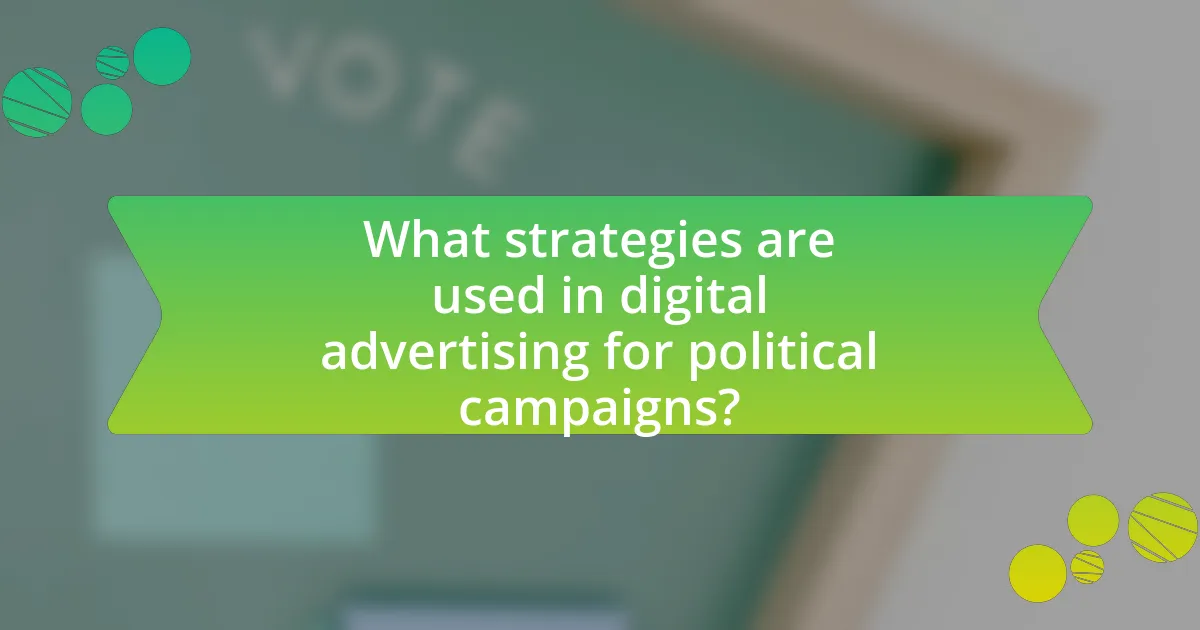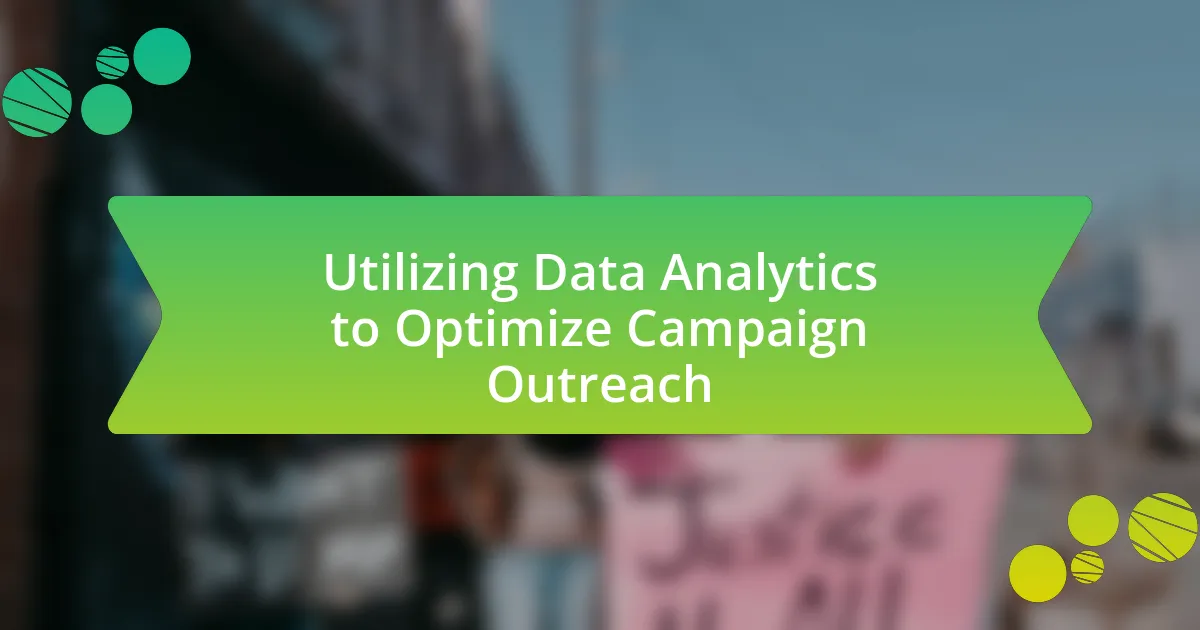Digital advertising has become a pivotal element in political campaigns, allowing candidates to efficiently target specific voter demographics and enhance engagement. The article explores how digital advertising has transformed traditional campaigning through precise demographic targeting, real-time analytics, and cost-effectiveness, exemplified by significant ad spending in recent elections. It also addresses the challenges of misinformation, regulatory compliance, and privacy concerns, while highlighting best practices for creating compelling content and measuring campaign success through key performance metrics. Overall, the article underscores the critical role of digital advertising in shaping modern political strategies and influencing voter behavior.

What is the Role of Digital Advertising in Political Campaigns?
Digital advertising plays a crucial role in political campaigns by enabling candidates to reach targeted audiences efficiently and effectively. It allows for precise demographic targeting, which enhances voter engagement and mobilization. For instance, during the 2020 U.S. presidential election, candidates spent over $1 billion on digital ads, highlighting the medium’s significance in shaping public opinion and influencing voter behavior. Additionally, platforms like Facebook and Google provide analytics that help campaigns measure the impact of their ads, allowing for real-time adjustments to strategies. This data-driven approach has transformed traditional campaigning, making digital advertising an essential tool for modern political strategies.
How has digital advertising transformed political campaigning?
Digital advertising has transformed political campaigning by enabling targeted outreach and real-time engagement with voters. Campaigns can now utilize data analytics to identify specific demographics and tailor messages that resonate with individual voter segments, significantly increasing the effectiveness of their outreach efforts. For instance, during the 2016 U.S. presidential election, the Trump campaign effectively used Facebook’s advertising platform to reach specific voter groups, resulting in a reported 5.9 million targeted ads that contributed to voter mobilization. This shift to digital platforms has also allowed for more cost-effective advertising compared to traditional media, with digital ad spending surpassing television ad spending in recent elections, reflecting a fundamental change in how campaigns allocate their resources.
What are the key features of digital advertising in this context?
The key features of digital advertising in the context of political campaigns include targeted messaging, real-time analytics, and cost-effectiveness. Targeted messaging allows campaigns to reach specific demographics based on data such as age, location, and interests, enhancing engagement and relevance. Real-time analytics provide immediate feedback on ad performance, enabling campaigns to adjust strategies quickly for optimal impact. Cost-effectiveness is evident as digital advertising often requires lower budgets compared to traditional media, allowing for broader reach and frequency. According to a study by the Pew Research Center, 69% of Americans use social media, making it a crucial platform for political outreach.
How does digital advertising differ from traditional advertising methods?
Digital advertising differs from traditional advertising methods primarily in its ability to target specific audiences and measure engagement in real-time. Unlike traditional methods such as print or television, which cast a wide net, digital advertising utilizes data analytics to reach defined demographics based on interests, behaviors, and location. For instance, a study by the Interactive Advertising Bureau found that digital ads can be tailored to reach specific voter segments, enhancing the effectiveness of political campaigns. Additionally, digital platforms allow for immediate feedback and performance tracking, enabling campaign managers to adjust strategies quickly based on real-time data, a capability that traditional advertising lacks.
Why is digital advertising important for political candidates?
Digital advertising is crucial for political candidates because it enables targeted outreach to specific voter demographics, enhancing engagement and mobilization. With over 4.5 billion active social media users globally, candidates can leverage platforms like Facebook and Twitter to disseminate their messages efficiently and effectively. Studies show that digital ads can increase voter turnout by up to 10%, demonstrating their significant impact on electoral outcomes. Additionally, digital advertising allows for real-time feedback and data analytics, enabling candidates to adjust their strategies based on voter responses and preferences.
What advantages does digital advertising provide over other forms of outreach?
Digital advertising offers targeted reach, cost-effectiveness, and measurable results compared to traditional outreach methods. It allows campaigns to specifically target demographics based on data analytics, ensuring that messages reach the most relevant audiences. For instance, platforms like Facebook and Google Ads enable precise targeting based on user behavior, interests, and location, which can significantly enhance engagement rates. Additionally, digital advertising typically incurs lower costs than print or broadcast media, allowing campaigns to allocate resources more efficiently. According to a report by the Interactive Advertising Bureau, digital ad spending in the U.S. reached $189 billion in 2020, reflecting its growing importance in outreach strategies. Furthermore, digital campaigns provide real-time analytics, enabling immediate adjustments based on performance metrics, which is not possible with traditional methods. This combination of targeting, cost efficiency, and measurable outcomes makes digital advertising a superior choice for political campaigns.
How does digital advertising enhance voter engagement?
Digital advertising enhances voter engagement by providing targeted messaging that reaches specific demographics effectively. This precision allows campaigns to tailor their content to resonate with the interests and concerns of different voter segments, increasing the likelihood of interaction. For instance, a study by the Pew Research Center found that 69% of adults in the U.S. use social media, making it a vital platform for political outreach. Additionally, digital advertising enables real-time feedback and interaction through comments and shares, fostering a sense of community and involvement among voters. This interactive nature of digital platforms has been shown to increase voter turnout, as evidenced by a report from the Harvard Kennedy School, which indicated that targeted digital ads can boost participation rates by up to 10%.

What strategies are used in digital advertising for political campaigns?
Digital advertising for political campaigns employs strategies such as targeted advertising, social media engagement, and data analytics. Targeted advertising allows campaigns to reach specific demographics based on factors like age, location, and interests, enhancing the effectiveness of their messaging. Social media engagement fosters direct interaction with voters, enabling campaigns to build communities and respond to public sentiment in real-time. Data analytics plays a crucial role by providing insights into voter behavior and preferences, allowing campaigns to optimize their strategies and allocate resources efficiently. For instance, the 2020 U.S. presidential campaign utilized Facebook and Google Ads to micro-target voters, demonstrating the impact of these strategies on voter outreach and engagement.
How do political campaigns utilize social media for advertising?
Political campaigns utilize social media for advertising by creating targeted ads, engaging with voters, and disseminating information rapidly. Campaigns leverage platforms like Facebook, Twitter, and Instagram to reach specific demographics based on user data, allowing for personalized messaging that resonates with potential voters. For instance, during the 2020 U.S. presidential election, campaigns spent over $1 billion on social media advertising, highlighting its significance in modern political strategy. Additionally, social media enables real-time interaction, allowing campaigns to respond to voter concerns and amplify their messages through shares and retweets, further enhancing their reach and impact.
What platforms are most effective for political digital advertising?
Social media platforms, particularly Facebook, Instagram, and Twitter, are the most effective for political digital advertising. These platforms allow targeted advertising based on user demographics, interests, and behaviors, which enhances engagement and reach. For instance, a study by the Pew Research Center found that 69% of adults in the U.S. use Facebook, making it a prime platform for political campaigns to connect with voters. Additionally, Instagram’s visual content appeals to younger demographics, while Twitter facilitates real-time engagement and discussions, further amplifying political messages.
How do campaigns tailor their messages for different social media audiences?
Campaigns tailor their messages for different social media audiences by analyzing demographic data, user behavior, and platform-specific trends. For instance, younger audiences on platforms like TikTok prefer short, engaging videos, while older demographics on Facebook respond better to detailed posts and community engagement. Research shows that 71% of millennials use Instagram, prompting campaigns to create visually appealing content that resonates with this age group. Additionally, campaigns utilize targeted advertising tools to segment audiences based on interests and interactions, ensuring that the messaging aligns with the values and preferences of each group. This strategic approach enhances engagement and increases the likelihood of message retention among diverse social media users.
What role does data analytics play in digital political advertising?
Data analytics plays a crucial role in digital political advertising by enabling campaigns to target specific voter demographics effectively. Through the analysis of vast amounts of data, political advertisers can identify patterns in voter behavior, preferences, and engagement, allowing for tailored messaging that resonates with different segments of the electorate. For instance, a study by the Pew Research Center found that 62% of Americans get their news from social media, highlighting the importance of targeted ads on these platforms. By leveraging data analytics, campaigns can optimize ad spend, improve engagement rates, and ultimately increase voter turnout, demonstrating the significant impact of data-driven strategies in modern political advertising.
How do campaigns use data to target specific voter demographics?
Campaigns use data to target specific voter demographics by analyzing voter behavior, preferences, and demographics through various data sources. This analysis allows campaigns to create tailored messages and advertisements that resonate with specific groups, such as age, gender, income level, and geographic location. For instance, campaigns often utilize voter registration databases, social media analytics, and consumer data to identify key demographics and their interests. According to a study by the Pew Research Center, 69% of Americans use social media, providing campaigns with a rich source of data to refine their targeting strategies. By leveraging this data, campaigns can optimize their outreach efforts, ensuring that their messages reach the most relevant audiences effectively.
What tools are available for analyzing the effectiveness of digital ads?
Tools available for analyzing the effectiveness of digital ads include Google Analytics, Facebook Ads Manager, and Adobe Analytics. Google Analytics provides insights into website traffic and user behavior, allowing advertisers to measure conversions and track the performance of their campaigns. Facebook Ads Manager offers detailed metrics on ad reach, engagement, and conversion rates specifically for ads run on the platform. Adobe Analytics enables comprehensive data analysis across multiple channels, providing insights into customer journeys and campaign effectiveness. These tools are widely used in the industry, with Google Analytics reporting that over 30 million websites utilize its services, demonstrating its significance in digital advertising analysis.

What challenges do political campaigns face with digital advertising?
Political campaigns face several challenges with digital advertising, including regulatory compliance, audience targeting, and misinformation management. Regulatory compliance is crucial as campaigns must navigate complex laws governing political advertising, which vary by region and platform. Audience targeting presents difficulties due to the need for precise demographic and psychographic data to effectively reach potential voters, while also contending with privacy concerns and data protection regulations. Misinformation management is another significant challenge, as campaigns must actively combat false narratives and ensure the accuracy of their messaging in a rapidly evolving digital landscape. According to a 2020 report by the Pew Research Center, 64% of Americans believe that misinformation has a significant impact on political discourse, highlighting the urgency for campaigns to address this issue effectively.
How do misinformation and fake news impact digital political advertising?
Misinformation and fake news significantly undermine the effectiveness of digital political advertising by distorting public perception and influencing voter behavior. Research indicates that exposure to false information can lead to increased polarization and mistrust in political messages, ultimately skewing the intended impact of advertising campaigns. For instance, a study published in the journal “Science” found that false news stories were 70% more likely to be retweeted than true stories, demonstrating how misinformation can spread rapidly and overshadow legitimate political discourse. This environment complicates the ability of political advertisers to convey accurate messages, as voters may become more skeptical of all information, including factual advertisements.
What measures can campaigns take to combat misinformation?
Campaigns can combat misinformation by implementing fact-checking initiatives, promoting media literacy, and utilizing transparent communication strategies. Fact-checking initiatives involve verifying claims made in advertisements and public statements, which can help clarify misinformation. For instance, organizations like FactCheck.org provide resources that campaigns can leverage to ensure their messaging is accurate. Promoting media literacy equips the public with skills to critically evaluate information sources, reducing the impact of false narratives. Additionally, transparent communication strategies, such as openly addressing misinformation and providing clear, factual responses, can build trust with the audience. Research indicates that campaigns that actively engage in these measures can significantly reduce the spread of misinformation and enhance voter trust.
How does misinformation affect voter perception and trust?
Misinformation significantly undermines voter perception and trust by creating confusion and fostering skepticism towards legitimate information sources. When voters encounter false or misleading information, their ability to make informed decisions is compromised, leading to a distorted understanding of candidates and issues. Research from the Pew Research Center indicates that 64% of Americans believe that misinformation has a major impact on their trust in government and political institutions. This erosion of trust can result in decreased voter turnout and increased polarization, as individuals become more reliant on biased or unverified sources that align with their pre-existing beliefs.
What are the ethical considerations in digital political advertising?
Ethical considerations in digital political advertising include transparency, misinformation, data privacy, and targeting practices. Transparency requires that political ads disclose their funding sources and the identities of sponsors, as mandated by regulations like the Federal Election Commission rules in the United States. Misinformation poses a significant risk, as false narratives can spread rapidly online, influencing voter perceptions and decisions; studies show that misleading information can sway public opinion significantly. Data privacy concerns arise from the collection and use of personal data for targeted advertising, which can infringe on individual privacy rights and lead to manipulation. Lastly, targeting practices can create echo chambers, reinforcing existing biases and limiting exposure to diverse viewpoints, which undermines democratic discourse. These ethical considerations are crucial for maintaining integrity and trust in the political process.
How do privacy concerns influence digital advertising strategies?
Privacy concerns significantly influence digital advertising strategies by prompting advertisers to adopt more transparent and ethical practices. As consumers become increasingly aware of data privacy issues, such as the Cambridge Analytica scandal, advertisers are compelled to prioritize user consent and data protection. This shift leads to the implementation of stricter data collection policies and a focus on contextual advertising rather than behavioral targeting. According to a 2021 survey by the Pew Research Center, 79% of Americans expressed concern about how their data is used by companies, which drives advertisers to seek alternative methods that respect user privacy while still achieving campaign goals.
What regulations govern digital advertising in political campaigns?
Digital advertising in political campaigns is primarily governed by regulations set forth by the Federal Election Commission (FEC) in the United States. These regulations require transparency in political advertising, mandating that all digital ads disclose their sponsors and adhere to contribution limits. Additionally, the Communications Act of 1934 and the Bipartisan Campaign Reform Act of 2002 impose rules on the content and funding of political advertisements, ensuring that they are not misleading and that they comply with financial reporting requirements. The FEC also oversees the enforcement of these regulations, which include penalties for non-compliance, thereby maintaining the integrity of political advertising in the digital space.
What best practices should political campaigns follow for effective digital advertising?
Political campaigns should prioritize targeted audience segmentation for effective digital advertising. By analyzing voter demographics, interests, and online behaviors, campaigns can tailor their messages to resonate with specific groups, increasing engagement and conversion rates. Research indicates that targeted ads can lead to a 50% higher engagement rate compared to non-targeted ads, demonstrating the importance of precision in digital outreach. Additionally, utilizing A/B testing allows campaigns to refine their messaging and visuals based on real-time feedback, optimizing ad performance. Implementing these best practices ensures that political campaigns maximize their digital advertising effectiveness.
How can campaigns create compelling content for digital platforms?
Campaigns can create compelling content for digital platforms by focusing on storytelling, audience engagement, and data-driven strategies. Storytelling allows campaigns to connect emotionally with voters, making messages relatable and memorable. Engaging the audience through interactive content, such as polls or quizzes, fosters participation and increases shareability. Data-driven strategies, including analyzing audience demographics and preferences, enable campaigns to tailor content effectively, ensuring it resonates with target groups. Research indicates that campaigns utilizing these methods see higher engagement rates, with a study by the Pew Research Center showing that 69% of adults in the U.S. use social media, making it a vital platform for reaching voters.
What metrics should campaigns track to measure success in digital advertising?
Campaigns should track metrics such as click-through rate (CTR), conversion rate, return on ad spend (ROAS), engagement rate, and cost per acquisition (CPA) to measure success in digital advertising. Click-through rate indicates how effectively ads attract clicks, with an average CTR of 2% considered good in political campaigns. Conversion rate measures the percentage of users who take a desired action after clicking an ad, with higher rates indicating successful messaging. Return on ad spend quantifies the revenue generated for every dollar spent on advertising, with a ROAS of 4:1 often seen as a benchmark for success. Engagement rate reflects how well the audience interacts with content, including likes, shares, and comments, which is crucial for building community support. Lastly, cost per acquisition assesses the cost-effectiveness of converting a lead into a supporter, with lower CPA values indicating more efficient campaigns. These metrics collectively provide a comprehensive view of campaign performance and effectiveness in reaching electoral goals.






